Finger osteomyelitis
Definition
Finger osteomyelitis, or bone whitlow, is a purulent inflammation of the bony structures of the finger. It can be primary (less common) or secondary. The primary pathology is manifested by intense twitching pain and significant hyperthermia combined with hyperemia, edema, and restriction of movement, occurring a few days after the finger injury or against the background of a remote purulent process. Secondary bone whitlow develops due to the spread of infection in other forms of the disease, accompanied by subfebrile fever and continued suppuration. It is diagnosed based on examination, radiography, and laboratory tests. Treatment is operative – opening, curettage, bone resection. Amputation is indicated in case of significant bone destruction.
General information
Bone whitlow is a type of purulent inflammation of finger tissues with bone lesions (osteomyelitis). It is a fairly common pathology; according to various data, it ranges from 37 to 60% in the total structure of purulent-inflammatory processes in the fingers of the hand. Primary osteomyelitis of the phalanx is detected in only 5-10% of patients; the remaining patients have secondary inflammation of the bone. The nail phalanx is affected in the vast majority of cases (about 80%). The disease is more often found in workers in industries with an increased likelihood of trauma and intensive contamination of hands with irritating substances – tractor drivers, mechanics, loaders, laborers, etc.
Causes
The direct cause of osteomyelitis of the finger is pyogenic bacteria, usually staphylococci, less often their associations with other microorganisms, pseudomonas bacillus, Escherichia coli, and cocci (enterococci, streptococci). The primary form develops with hematogenous entry of infection from distant purulent foci and paraosseous hematomas. The causes of the secondary purulent process become:
- Subcutaneous whitlow occurs in the majority of cases and is associated with marked local intoxication and severe local blood circulation disorders arising from inflammation of the tissue adjacent to the bone tissue of the finger. It most often affects the distal phalanx.
- Tendon and joint whitlow. Occurs less frequently than subcutaneous whitlow. Usually, it precedes the purulent fusion of the primary and middle phalanges bones.
- Other forms of whitlow. In some cases, osteomyelitis of the distal phalanx is found in paronychia – a whitlow of skin next to the nail, but such cases account for a small proportion of the incidence.
Classification
Taking into account the etiology, primary (arising from trauma or hematogenous) and secondary (contact with other types of disease) osteomyelitis of the finger are distinguished. Since osteomyelitis mainly affects the distal phalanges, aclassification has been developed that reasonably allows us to determine the treatment tactics for this type of pathology. Three types of lesions of bone structures are distinguished:
- Marginal or longitudinal sequestration. Bone destruction is localized, the periosteum is only slightly damaged, and complete bone repair is possible. In the presence of a marginal sequestrum, the mobility of the finger is preserved after recovery. In longitudinal sequestration, the distal joint of the finger is involved in the process, and the outcome is ankylosis.
- Sequestrum with preservation of the base of the phalanx. The purulent process is localized above the base of the bone; the epiphysis is unchanged. Independent blood supply of the epiphyseal and diaphyseal zones of the bone provides favorable conditions for its recovery with sufficient preservation of the periosteum. The decision to save or amputate the finger is made individually, taking into account the size of the sequestrum and the duration of the disease.
- Complete sequestration of the phalanx. The altered bone is surrounded on all sides by a pus-filled cavity. The suppuration extends to the joint and tendon sheath. The periosteum is completely destroyed, or small areas remain incapable of complete regeneration. Amputation is required.
Symptoms of bone whitlow
In secondary lesions, the distal phalanges of the I, II, and III fingers are usually affected. At first, there is a characteristic clinical picture of subcutaneous whitlow, accompanied by local swelling, hyperemia, throbbing pain on the palmar surface of the finger, weakness, and fever. Then, a focus of suppuration is formed in the affected area, independently opened on the skin or drained by a purulent surgeon; local and general signs of inflammation decrease. The spread of pus to bony structures is manifested by a repeated increase in symptoms, which in the initial stages of osteomyelitis, however, does not reach the degree of severity characteristic of subcutaneous whitlow.
In primary lesions, whitlow develops acutely. The phalanx swells, the skin turns red, and then becomes purple-blue, there is intense twitching pain. The finger is in a position of forced flexion; active and passive movements cause increased pain syndrome. There is significant general hyperthermia; body temperature sometimes reaches 40˚C. With the progression of the primary and secondary process, a bulbous enlargement of the finger is detected. The skin on the affected phalanx is tense, smooth, and shiny. The phalanx is painful throughout. Areas of necrosis are formed. Fistulas are formed and are usually located in the subnail zone. Deformities associated with the destruction of soft tissue and bone structures may occur.
Diagnosis
Diagnosis is made by specialists in purulent surgery when the patient goes to the outpatient clinic less often – in emergency hospitalization due to the pronounced phenomena of the purulent process. The characteristic anamnesis, the typical clinical picture of the disease, and the data of additional studies are considered in the diagnosis process. The examination plan includes the following measures:
- Interview, examination. In the primary process, the history reveals trauma to the finger or the presence of a remote purulent focus. In the secondary variant, it is established that the patient has suffered from another form of whitlow for the previous two weeks or more. Examination reveals swelling, redness, and a fistula with purulent discharge. Careful probe insertion reveals a pitted bone surface.
- Radiography. The radiologic sign of the disease is irregular lucency of the phalanx, caused by reactive osteoporosis, combined with obliteration of the contours and, later – pitted contours and foci of destruction. Sometimes, with the progression of inflammation, the bone on the radiograph of the finger is almost not visible, which can be mistaken as necrosis. In necrosis, the shadow of the bone is preserved, and on its background is seen sequestrum, which can be displaced over time. When the joint is involved, the articular gap is narrowed, and the articulating surfaces of the bones become irregular.
- Laboratory tests. Purulent inflammation is accompanied by characteristic laboratory changes: elevated ESR, leukocytosis with a left shift, and the presence in the blood of rheumatoid factor, C-reactive protein, and antistreptolysin-O. Seeding of wound discharge indicates the presence of pus microflora and allows us to determine its sensitivity to antibiotics.
Treatment of finger osteomyelitis
Treatment is surgical only. The location of the incision is chosen, taking into account the location of the fistula and radiographic data, based on the principles of maximum preservation of function and the working surface of the finger. Usually, the opening of whitlow is carried out by widening the fistulous passage. Both bone sequestrations and the affected surrounding tissue are subject to excision. Removing non-viable areas has peculiarities associated with the insignificant tissue volume in this area.
The removed affected bone is then proceeded, which should also be highly economical. Loose bone sequestrations are excised. Separately located healthy areas that retain contact with the periosteum are left even if the prognosis for their recovery is uncertain. The wound is washed with a tight jet of hypertonic solution from a syringe. Subsequently, dressings are performed, and general antibiotic therapy is supplemented with the introduction of antibiotics into the focus of inflammation.
If there are no prospects for phalangeal restoration and there is a threat of further spread of infection, the finger is amputated or disarticulated. When deciding on amputation of the first finger, its functional significance is taken into account; if possible, every millimeter of its length should be preserved, even if there is a threat of deformity and ankylosis since a deformed or immobile finger is often more functional than its stump. If the other fingers are significantly affected, the level of amputation is chosen to create a functional residual limb with a scar-free working surface.
All these treatment options are available in more than 250 hospitals worldwide (https://doctor.global/results/diseases/finger-osteomyelitis). For example, Finger/toe amputation surgery can be done in following countries:
Turkey$1.6 K in 2 clinics
China$4.9 K in 2 clinics
Germany$5.8 K in 10 clinics
Israel$7.8 K in 6 clinics
United States$8.9 K – 22.5 K in 15 clinics.
Prognosis and prevention
The prognosis of bone whitlow is determined by the osteomyelitis process’s prevalence, the periosteum’s preservation, and the degree of involvement of surrounding structures. With timely treatment of marginal sequestrations, the outcome is usually favorable. In other cases, shortening and/or impaired finger mobility and scar deformities are possible in the distant period. Prophylaxis consists of preventing industrial and household traumas, using protective equipment (gloves) when working with irritating substances, timely referral to a surgeon in case of inflammation and trauma of the fingers, and adequate opening and drainage of other forms of whitlow.

